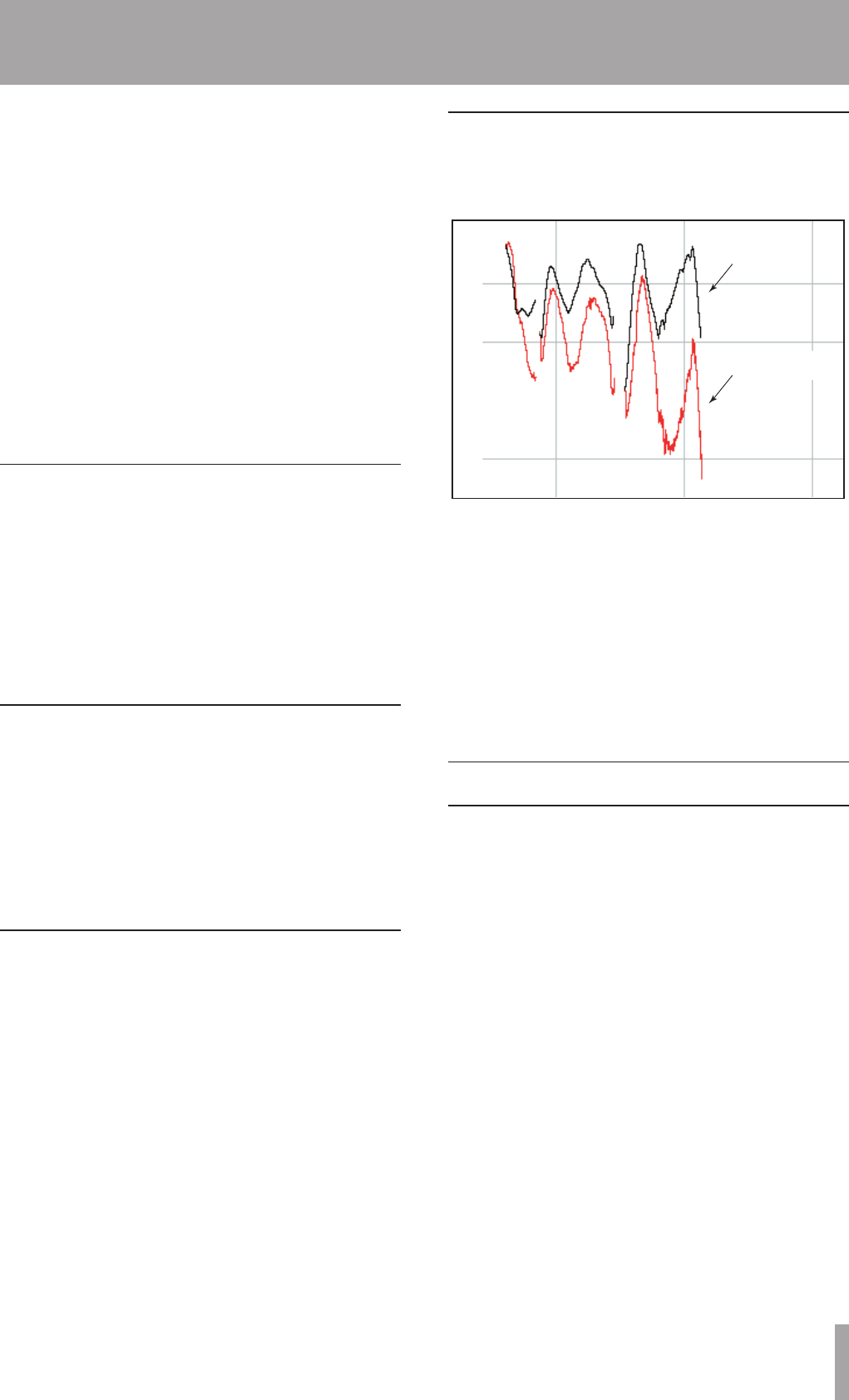
TASCAM TA-1VP 9
intonation correction to be performed on all vocals and
almost all instruments.
Of course, the TA-1VP will not detect pitch when the input
waveform is not periodic. As demonstrated above, the
TA-1VP will fail to tune up even a unison violin section.
But this can also occasionally be a problem with solo
voice and solo instruments as well. Consider, for example,
an exceptionally breathy voice, or a voice recorded in an
unavoidably noisy environment. The added signal is non-
periodic, and the TA-1VP will have difficulty determining
the pitch of the composite (voice + noise) sound. Luckily,
there is a control (the Sensitivity control, discussed in
Chapter 5) that will let the TA-1VP be a bit more casual
about what it considers “periodic.” Experimenting with
this setting will often allow the TA-1VP to track even noisy
signals.
How Auto-Tune corrects pitch
Auto-Tune works by continuously tracking the pitch
of an input sound and comparing it to a user-defined
scale. The scale tone closest to the input is continuously
identified. If the input pitch exactly matches the scale
tone, no correction is applied. If the input pitch varies
from the desired scale pitch, an output pitch is generated
which is closer to the scale tone than the input pitch. (The
exact amount of correction is controlled by the Speed
parameter, described below and in Chapter 5.)
Scales
The heart of Auto-Tune pitch correction is the Scale. The
TA-1VP comes with 25 preprogrammed scales. For each
Scale you can define which notes will sound and which
won’t. And for each note that will sound, you can decide
whether the TA-1VP will apply pitch correction to input
pitches near that note or leave those pitches uncorrected.
You can also edit any of the preprogrammed scales and
save your custom scale as part of a Preset.
Speed
You also have control over how rapidly, in time, the pitch
adjustment is made toward the scale tone. This is set with
the Speed control (see Chapter 5 for more details).
Fast Speed
•
settings are more appropriate for short
duration notes and for mechanical instruments, like an
oboe or clarinet, whose pitch typically changes almost
instantly. A fast enough setting will also minimize or
completely remove a vibrato. At the fastest setting, you
will produce the now-infamous “Cher effect.”
Slow Speed
•
settings, on the other hand, are
appropriate for longer notes where you want
expressive pitch gestures (like vibrato) to come through
at the output and for vocal and instrumental styles that
are typified by gradual slides (portamento) between
pitches. An appropriately selected slow setting can
leave a vibrato unmodified while the average pitch is
accurately adjusted to be in tune.
An example
As an example, consider this before-and-after graphic
representation of the pitch of a vocal phrase that contains
both vibrato and expressive gestures.
10.0 10.5 11.0
D3
B2
C
#
3
ORIGINAL
PERFORMANCE
CORRECTED
BY TA-1VP
In the original performance, we can see that although
the final note should be centered around D, the vocalist
allowed the tail of the note to fall nearly three semitones
flat. The “after” plot is the result of passing this phrase
through the TA-1VP set to a D Major Scale (with C# and
B set to ”Blank”) and a Speed setting of 10. That Speed
causes the pitch center to be moved to D, while still
retaining the vibrato and expressive gestures. (Setting
C# and B to ”Blank” is necessary to keep the TA-1VP from
trying to correct the seriously flat tail of the last note to
those pitches. See Chapter 5 for more details.)
Antares Microphone Modeling
If you’ve spent any time flipping through the pages of pro
audio magazines, you have almost certainly noticed the
intense focus on microphones. From the proliferation of
exotic new mics to the almost cult-like following of certain
historical classics, never has the choice been greater. But
amassing a substantial collection of high-end mics is
financially prohibitive for all but the most well-off studios.
Now, using Antare's patented Spectral Shaping Tool™
technology, we’ve created digital models of a variety
of microphones. Simply tell the TA-1VP what type of
microphone you are actually using and what type of
microphone you’d like it to sound like. It’s as simple as
that.
With the TA-1VP, you can record each track through a
model of the type of mic that will best produce that ideal
sound you’re looking for. Or use it in live performance
to get the sound of mics you’d never consider using on
stage. You can even use it during mixdown to effectively
change the mic on an already recorded track. And for that
final touch of perfection, you can even add some tasty
tube saturation.
2 – Introducing the TASCAM TA-1VP Vocal Producer


















